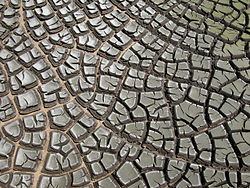- Mudcrack
-
 Mud cracks in sewage sludge in Kos, Greece.
Mud cracks in sewage sludge in Kos, Greece.
Mudcracks (also known as desiccation cracks or mud cracks) are sedimentary structures formed as muddy sediment dries and contracts.[1][2]
Contents
Formation
Naturally forming mudcracks start as wet, muddy sediment desiccates, causing contraction via a decrease in tensile strength[citation needed]. Individual cracks join up forming a polygonal, interconnected network. These cracks may later be filled with sediment and form casts on the base of the overlying bed.[citation needed]
Syneresis cracks are broadly similar features that form from subaqueous shrinkage of muddy sediment caused by differences in salinity or chemical conditions,[1] rather than subaerial exposure and desiccation. Syneresis cracks can be distinguished from mudcracks because they tend to be discontinuous, sinuous, and trilete or spindle-shaped.[3]
Morphology and classification
Mudcracks are generally polygonal in plan view and v-shaped in cross section. The "v" opens towards the top of the bed and the crack tapers downward. Allen (1982) proposed a classification scheme for mud cracks based on their completeness, orientation, shape, and type of infill.[3]
Completeness
Complete mudcracks form an interconnected network. The connection of cracks often occurs when individual cracks join together forming a larger continuous crack.[3] Incomplete mudcracks are not connected to each other but still form in the same region or location as the other cracks.[3]
Plan-view geometry
Orthogonal intersections can have a preferred orientation or may be random. In oriented orthogonal cracks, the cracks are usually complete and bond to one another forming irregular polygonal shapes and often rows of irregular polygons. In random orthogonal cracks, the cracks are incomplete and unoriented therefore they do not connect or make any general shapes. Although they do not make general shapes they are not perfectly geometric.[4] Non-orthogonal mudcracks have a geometric pattern. In uncompleted non-orthogonal cracks they form as a single three point star shape that is composed of three cracks. They could also form with more than three cracks but three cracks in commonly considered the minimum. In completed non-orthogonal cracks, they form a very geometric pattern. The pattern resembles small polygonal shaped tiles in a repetitive pattern.[3]
Mud curls
Mud curls form during one of the final stages in desiccation. Mud curls commonly occur on the exposed top layer of very thinly bedded mud rocks. When mud curls form, the water that is inside the sediment begins to evaporate causing the stratified layers to separate. The individual top layer is much weaker than multiple layers and is therefore able to contract and form curls as desiccation occurs.[4] If transported by later currents, mud curls may be preserved as mud-chip rip-up clasts.
Environments and substrates
Naturally occurring mud cracks form in sediment that was once saturated with water. Abandoned river channels, floodplain muds, and dried ponds are localities that form mudcracks.[5] Mud cracks can also be indicative of a predominately sunny or shady environment of formation. Rapid drying, which occurs in sunny environments, results in widely spaced, irregular mud cracks, while closer spaced more regular mud cracks indicates a shady formation environment.[6] Polygonal crack networks similar to mudcracks can form in man-made materials such as ceramic glazes, paint film, and poorly made concrete. Similar features also occur in frozen ground, lava flows (as columnar basalt), and igneous dykes and sills.[7]
Preservation
 Ancient mudcracks preserved on the base of a bed of sandstone.
Ancient mudcracks preserved on the base of a bed of sandstone.
Mud cracks can be preserved as v-shaped cracks on the top of a bed of muddy sediment or as casts on the base of the overlying bed. When they are preserved on the top of a bed, the cracks look as they were at the time of formation. When they are preserved on the bottom of the bedrock the cracks are filled in with younger, overlying sediment. In most bottom-of-bed examples the cracks are the part that sticks out most. Bottom-of-bed preservation occurs when mud cracks that have already formed and are completely dried are covered with fresh wet sediment and buried. Through burial and pressure the new wet sediment is further pushed into the cracks where it dries and hardens. The mud cracked rock is then later exposed to erosional factors.[2] In these cases, the original mud cracks will erode faster than the newer material filling in the spaces. These types of mud cracks are useful for geologists to determine the vertical orientation of rock samples that have been altered through folding or faulting.[8]
References
- ^ a b Jackson, J.A., 1997, Glossary of Geology (4th ed.), American Geological Institute, Alexandria, VA, 769 p.
- ^ a b Stow, D.A., 2005, Sedimentary Rocks in the Field, Academic Press, London, 320 p.
- ^ a b c d e Allen, J.R.L., 1982, Sedimentary Structures: Their Character and Physical Basis (v. 2): Elsevier, Oxford, 593 p.
- ^ a b Linholm, R., 1987, A Practical Approach to Sedimentology, Allen and Unwin, London, 276 p.
- ^ Collinson, J.; Thompson, D. (1989). Sedimentary Structures (2nd ed.). London: Unwin Hyman. ISBN 0044451725.
- ^ Kindle, E. M. (1917). "Some Factors Affecting the Development of Mud-Cracks". Journal of Geology 25 (2): 135–144. JSTOR 30060962.
- ^ Boggs, J. S. (2006). Principles of Sedimentology and Stratigraphy (4th ed.). Upper Saddle River, New Jersey: Pearson Education. ISBN 0131547283.
- ^ Middleton, Gerard V. (2003). Encyclopedia of sediments and sedimentary rocks. Springer. p. 212. ISBN 9781402008726. http://books.google.com/books?id=r_2Ia8wOBlgC&pg=PA212. Retrieved 22 June 2011.
External links
 Media related to Mudcracks at Wikimedia CommonsCategories:
Media related to Mudcracks at Wikimedia CommonsCategories:- Sedimentary structures
- Patterned grounds
- Sedimentary rocks
- Geology terminology
Wikimedia Foundation. 2010.




